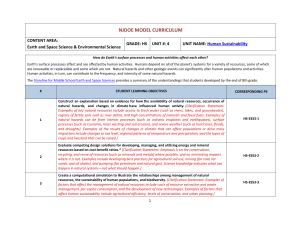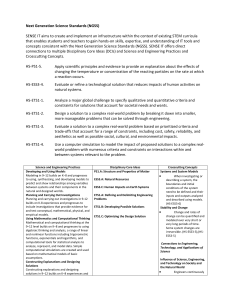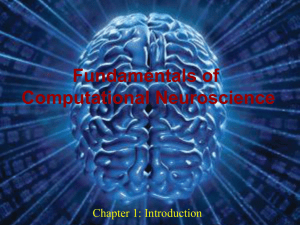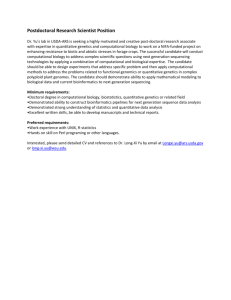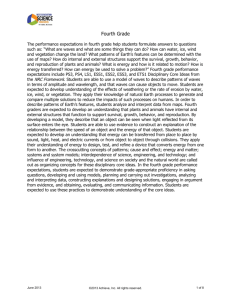HS_EnergyResources
advertisement
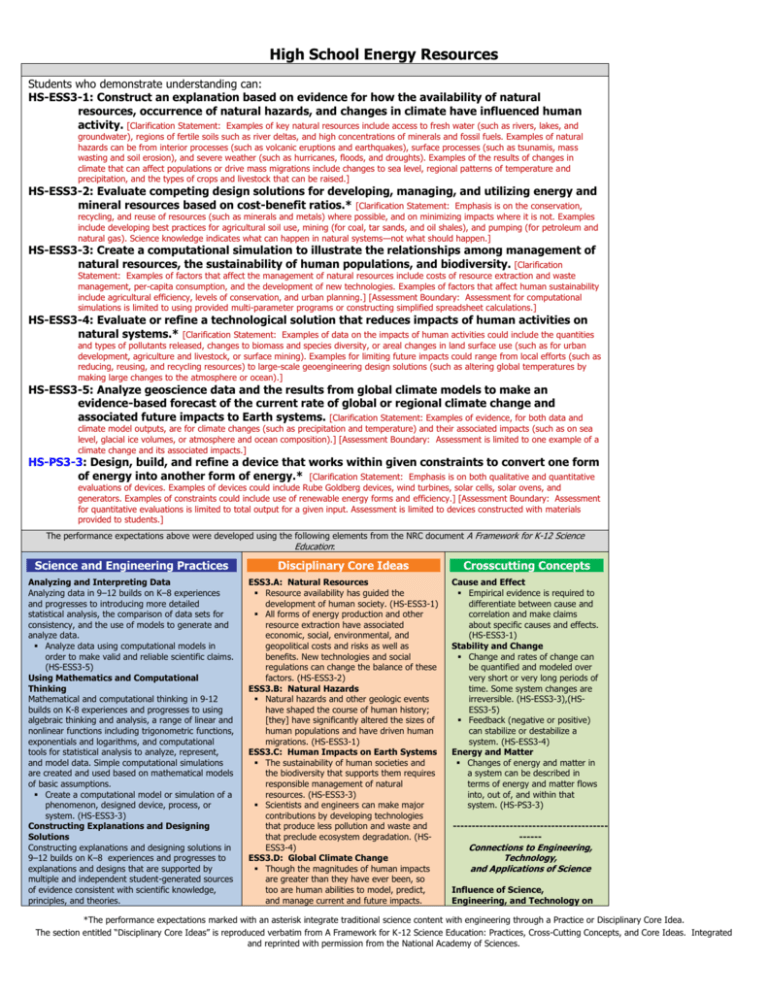
High School Energy Resources Students who demonstrate understanding can: HS-ESS3-1: Construct an explanation based on evidence for how the availability of natural resources, occurrence of natural hazards, and changes in climate have influenced human activity. [Clarification Statement: Examples of key natural resources include access to fresh water (such as rivers, lakes, and groundwater), regions of fertile soils such as river deltas, and high concentrations of minerals and fossil fuels. Examples of natural hazards can be from interior processes (such as volcanic eruptions and earthquakes), surface processes (such as tsunamis, mass wasting and soil erosion), and severe weather (such as hurricanes, floods, and droughts). Examples of the results of changes in climate that can affect populations or drive mass migrations include changes to sea level, regional patterns of temperature and precipitation, and the types of crops and livestock that can be raised.] HS-ESS3-2: Evaluate competing design solutions for developing, managing, and utilizing energy and mineral resources based on cost-benefit ratios.* [Clarification Statement: Emphasis is on the conservation, recycling, and reuse of resources (such as minerals and metals) where possible, and on minimizing impacts where it is not. Examples include developing best practices for agricultural soil use, mining (for coal, tar sands, and oil shales), and pumping (for petroleum and natural gas). Science knowledge indicates what can happen in natural systems—not what should happen.] HS-ESS3-3: Create a computational simulation to illustrate the relationships among management of natural resources, the sustainability of human populations, and biodiversity. [Clarification Statement: Examples of factors that affect the management of natural resources include costs of resource extraction and waste management, per-capita consumption, and the development of new technologies. Examples of factors that affect human sustainability include agricultural efficiency, levels of conservation, and urban planning.] [Assessment Boundary: Assessment for computational simulations is limited to using provided multi-parameter programs or constructing simplified spreadsheet calculations.] HS-ESS3-4: Evaluate or refine a technological solution that reduces impacts of human activities on natural systems.* [Clarification Statement: Examples of data on the impacts of human activities could include the quantities and types of pollutants released, changes to biomass and species diversity, or areal changes in land surface use (such as for urban development, agriculture and livestock, or surface mining). Examples for limiting future impacts could range from local efforts (such as reducing, reusing, and recycling resources) to large-scale geoengineering design solutions (such as altering global temperatures by making large changes to the atmosphere or ocean).] HS-ESS3-5: Analyze geoscience data and the results from global climate models to make an evidence-based forecast of the current rate of global or regional climate change and associated future impacts to Earth systems. [Clarification Statement: Examples of evidence, for both data and climate model outputs, are for climate changes (such as precipitation and temperature) and their associated impacts (such as on sea level, glacial ice volumes, or atmosphere and ocean composition).] [Assessment Boundary: Assessment is limited to one example of a climate change and its associated impacts.] HS-PS3-3: Design, build, and refine a device that works within given constraints to convert one form of energy into another form of energy.* [Clarification Statement: Emphasis is on both qualitative and quantitative evaluations of devices. Examples of devices could include Rube Goldberg devices, wind turbines, solar cells, solar ovens, and generators. Examples of constraints could include use of renewable energy forms and efficiency.] [Assessment Boundary: Assessment for quantitative evaluations is limited to total output for a given input. Assessment is limited to devices constructed with materials provided to students.] The performance expectations above were developed using the following elements from the NRC document A Framework for K-12 Science Education: Science and Engineering Practices Disciplinary Core Ideas Crosscutting Concepts Analyzing and Interpreting Data Analyzing data in 9–12 builds on K–8 experiences and progresses to introducing more detailed statistical analysis, the comparison of data sets for consistency, and the use of models to generate and analyze data. Analyze data using computational models in order to make valid and reliable scientific claims. (HS-ESS3-5) Using Mathematics and Computational Thinking Mathematical and computational thinking in 9-12 builds on K-8 experiences and progresses to using algebraic thinking and analysis, a range of linear and nonlinear functions including trigonometric functions, exponentials and logarithms, and computational tools for statistical analysis to analyze, represent, and model data. Simple computational simulations are created and used based on mathematical models of basic assumptions. Create a computational model or simulation of a phenomenon, designed device, process, or system. (HS-ESS3-3) Constructing Explanations and Designing Solutions Constructing explanations and designing solutions in 9–12 builds on K–8 experiences and progresses to explanations and designs that are supported by multiple and independent student-generated sources of evidence consistent with scientific knowledge, principles, and theories. ESS3.A: Natural Resources Resource availability has guided the development of human society. (HS-ESS3-1) All forms of energy production and other resource extraction have associated economic, social, environmental, and geopolitical costs and risks as well as benefits. New technologies and social regulations can change the balance of these factors. (HS-ESS3-2) ESS3.B: Natural Hazards Natural hazards and other geologic events have shaped the course of human history; [they] have significantly altered the sizes of human populations and have driven human migrations. (HS-ESS3-1) ESS3.C: Human Impacts on Earth Systems The sustainability of human societies and the biodiversity that supports them requires responsible management of natural resources. (HS-ESS3-3) Scientists and engineers can make major contributions by developing technologies that produce less pollution and waste and that preclude ecosystem degradation. (HSESS3-4) ESS3.D: Global Climate Change Though the magnitudes of human impacts are greater than they have ever been, so too are human abilities to model, predict, and manage current and future impacts. Cause and Effect Empirical evidence is required to differentiate between cause and correlation and make claims about specific causes and effects. (HS-ESS3-1) Stability and Change Change and rates of change can be quantified and modeled over very short or very long periods of time. Some system changes are irreversible. (HS-ESS3-3),(HSESS3-5) Feedback (negative or positive) can stabilize or destabilize a system. (HS-ESS3-4) Energy and Matter Changes of energy and matter in a system can be described in terms of energy and matter flows into, out of, and within that system. (HS-PS3-3) ---------------------------------------------- Connections to Engineering, Technology, and Applications of Science Influence of Science, Engineering, and Technology on *The performance expectations marked with an asterisk integrate traditional science content with engineering through a Practice or Disciplinary Core Idea. The section entitled “Disciplinary Core Ideas” is reproduced verbatim from A Framework for K-12 Science Education: Practices, Cross-Cutting Concepts, and Core Ideas. Integrated and reprinted with permission from the National Academy of Sciences. High School Energy Resources Construct an explanation based on valid and reliable evidence obtained from a variety of sources (including students’ own investigations, models, theories, simulations, peer review) and the assumption that theories and laws that describe the natural world operate today as they did in the past and will continue to do so in the future. (HS-ESS3-1) Design or refine a solution to a complex realworld problem, based on scientific knowledge, student-generated sources of evidence, prioritized criteria, and tradeoff considerations. (HS-ESS3-4) Design, evaluate, and/or refine a solution to a complex real-world problem, based on scientific knowledge, student-generated sources of evidence, prioritized criteria, and tradeoff considerations. (HS-PS3-3) Engaging in Argument from Evidence Engaging in argument from evidence in 9–12 builds on K–8 experiences and progresses to using appropriate and sufficient evidence and scientific reasoning to defend and critique claims and explanations about natural and designed world(s). Arguments may also come from current scientific or historical episodes in science. Evaluate competing design solutions to a realworld problem based on scientific ideas and principles, empirical evidence, and logical arguments regarding relevant factors (e.g. economic, societal, environmental, ethical considerations). (HS-ESS3-2) (HS-ESS3-5) ETS1.B: Developing Possible Solutions When evaluating solutions, it is important to take into account a range of constraints, including cost, safety, reliability, and aesthetics, and to consider social, cultural, and environmental impacts. (secondary to HS-ESS3-2),(secondary HS-ESS3-4) PS3.A: Definitions of Energy At the macroscopic scale, energy manifests itself in multiple ways, such as in motion, sound, light, and thermal energy. (HS-PS33) PS3.D: Energy in Chemical Processes Although energy cannot be destroyed, it can be converted to less useful forms—for example, to thermal energy in the surrounding environment. (HS-PS3-3),(HSPS3-4) ETS1.A: Defining and Delimiting Engineering Problems Criteria and constraints also include satisfying any requirements set by society, such as taking issues of risk mitigation into account, and they should be quantified to the extent possible and stated in such a way that one can tell if a given design meets them. (secondary to HS-PS3-3) Society and the Natural World Modern civilization depends on major technological systems. (HSESS3-1),(HS-ESS3-3),(HS-PS3-3) Engineers continuously modify these technological systems by applying scientific knowledge and engineering design practices to increase benefits while decreasing costs and risks. (HS-ESS3-2),(HSESS3-4),(HS-PS3-3) New technologies can have deep impacts on society and the environment, including some that were not anticipated. (HS-ESS3-3) Analysis of costs and benefits is a critical aspect of decisions about technology. (HS-ESS3-2) *The performance expectations marked with an asterisk integrate traditional science content with engineering through a Practice or Disciplinary Core Idea. The section entitled “Disciplinary Core Ideas” is reproduced verbatim from A Framework for K-12 Science Education: Practices, Cross-Cutting Concepts, and Core Ideas. Integrated and reprinted with permission from the National Academy of Sciences.



